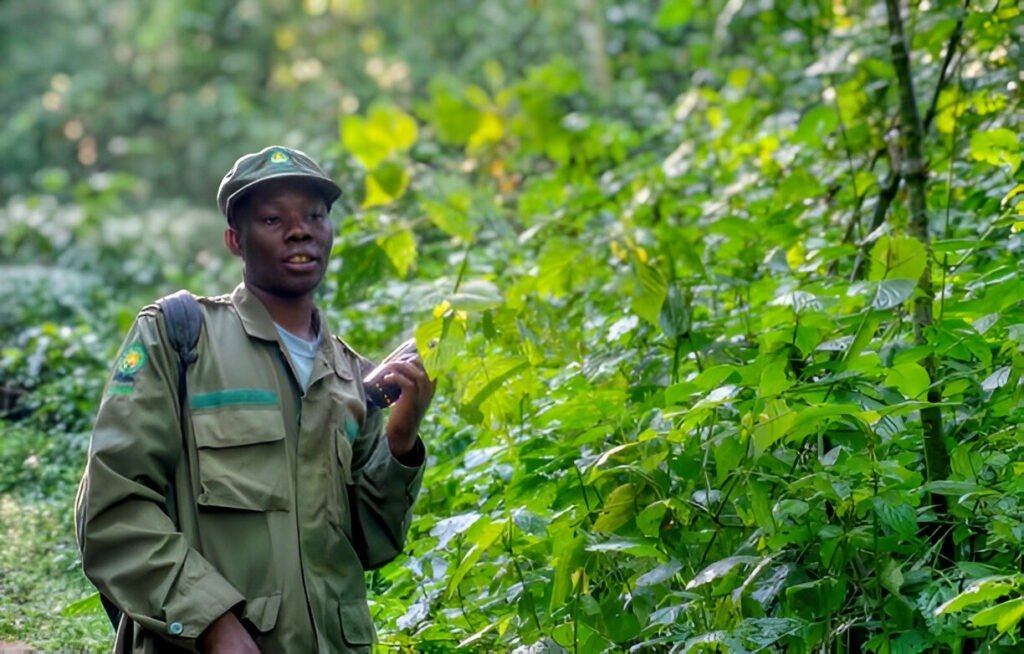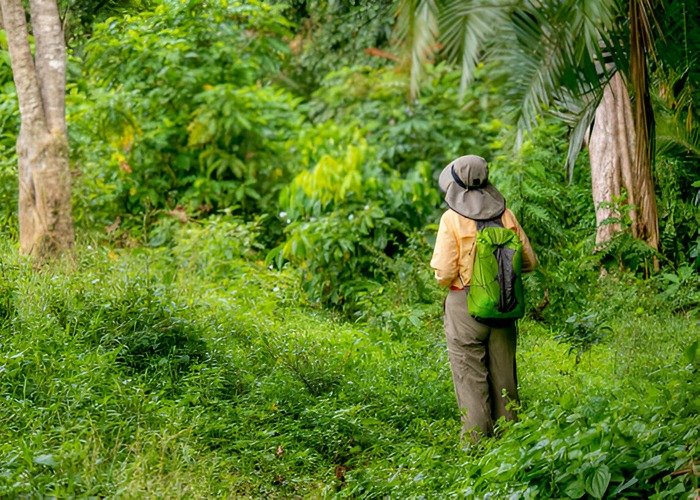
Gorilla trekking in Uganda is an adventure of a lifetime, offering an unparalleled opportunity to get up close and personal with the majestic mountain gorillas in their natural habitat.
This thrilling experience, set against the backdrop of Uganda’s lush forests and rolling hills, is both a physical challenge and a deeply moving encounter with one of our closest relatives in the animal kingdom.
In this comprehensive guide, we will explore what to expect during a gorilla trekking expedition in Uganda and how to prepare for this unforgettable journey.
Gorilla trekking in Uganda has gained international acclaim, attracting wildlife enthusiasts, adventure seekers, and nature lovers from around the world.
Uganda is home to over half of the world’s remaining mountain gorilla population, making it one of the prime destinations for this unique wildlife experience.
This blog will cover everything you need to know about gorilla trekking in Uganda, from the best time to visit and what to pack to the detailed trekking experience and conservation efforts.

Why Gorilla Trekking in Uganda?
Uganda is one of the only three countries in the world where you can trek to see mountain gorillas in the wild, the other two being Rwanda and the Democratic Republic of Congo.
Uganda offers a unique blend of affordability, accessibility, and breathtaking scenery. The country boasts two main gorilla trekking destinations: Bwindi Impenetrable National Park and Mgahinga Gorilla National Park.
Both parks offer a rich biodiversity, stunning landscapes, and the chance to see gorillas in their natural environment.
Bwindi Impenetrable National Park

Bwindi Impenetrable National Park is a UNESCO World Heritage site renowned for its incredible biodiversity and dense forest.
It is home to over 400 mountain gorillas, making it one of the best places for gorilla trekking. The park’s challenging terrain provides a truly immersive jungle experience.
Mgahinga Gorilla National Park

Mgahinga Gorilla National Park, though smaller, offers a similarly rewarding experience. It is part of the larger Virunga Conservation Area, which spans Uganda, Rwanda, and the DRC.
This park is known for its scenic beauty, with the backdrop of the Virunga volcanoes adding to the adventure.
Best Time to Go Gorilla Trekking in Uganda
The best time for gorilla trekking in Uganda is during the dry seasons, from June to August and December to February. During these months, the trails are less muddy and easier to navigate.
However, gorilla trekking is possible year-round, and some travelers prefer the lush green landscapes and fewer crowds of the rainy seasons.
Peak Season vs. Off-Season
1. Peak Season (June to September, December to February):
The dry season offers more comfortable trekking conditions and higher chances of clear weather. However, it is also the busiest time, so permits sell out quickly.
2. Off-Season (March to May, October to November):
The rainy season means fewer tourists and more availability of permits. The forest is also at its greenest, which can enhance the experience despite the wetter trails.
How to Get Gorilla Trekking Permits
Securing a gorilla trekking permit is a crucial step in planning your adventure. Permits are issued by the Uganda Wildlife Authority (UWA) and are limited to protect the gorillas and their habitat.
It’s advisable to book your permit well in advance, especially during peak season.
Cost of Gorilla Trekking Permits
As of 2024, the cost of a gorilla trekking permit in Uganda is $800 for foreign non-residents and UGX 300,000 for East African citizens. These fees contribute to conservation efforts and community development.?
Where to Buy Gorilla Trekking Permits
You can purchase permits directly from the Uganda Wildlife Authority or through a licensed tour operator.
Many travelers prefer using a tour operator for convenience, as they can assist with all logistical arrangements.
Preparing for Your Gorilla Trekking Adventure

Proper preparation is essential to ensure a safe and enjoyable gorilla trekking experience. Here are some key aspects to consider:
Physical Fitness
Gorilla trekking can be physically demanding, involving several hours of hiking through steep and sometimes muddy terrain.
It’s advisable to engage in regular physical activity and build stamina before your trip. Hiking, walking, and cardio exercises are particularly beneficial.
What to Pack for Gorilla Trekking

Packing the right gear can make a significant difference in your trekking experience. Here’s a comprehensive packing list:
- Hiking Boots: Sturdy, waterproof hiking boots with good ankle support are essential.
- Clothing: Lightweight, moisture-wicking clothing is ideal. Long-sleeved shirts and long pants offer protection against insects and vegetation. A waterproof jacket is also recommended.
- Gloves: Gardening gloves can protect your hands from thorny plants.
- Hat and Sunglasses: A wide-brimmed hat and UV-protective sunglasses shield you from the sun.
- Daypack: A comfortable daypack to carry your essentials, including water, snacks, and extra clothing.
- Water Bottle: Staying hydrated is crucial. Consider a hydration pack for convenience.
- Insect Repellent: To protect against mosquitoes and other insects.
- Sunblock: High-SPF sunblock to protect your skin.
- Binoculars and Camera: To capture the incredible wildlife and scenery.
Health Precautions
Ensure you are in good health before embarking on a gorilla trek. Vaccinations for yellow fever, hepatitis, and typhoid are recommended. It’s also wise to carry a basic first aid kit, including any personal medications.
Understanding the Trekking Rules

To protect the gorillas and ensure a safe experience for all, several rules must be followed during gorilla trekking:
- Maintain a Distance: Keep a distance of at least 7 meters (21 feet) from the gorillas.
- No Flash Photography: Flash can disturb the gorillas.
- Do Not Touch the Gorillas: Avoid any direct contact.
- Follow the Guide’s Instructions: Always adhere to the guidance and instructions provided by your trekking guide.
- Stay Calm and Quiet: Keep your voice low and avoid sudden movements.
The Gorilla Trekking Experience
The day of your gorilla trek begins early in the morning. After a briefing by the park rangers, you will be assigned to a small group and a specific gorilla family to track. Each group is accompanied by experienced guides and trackers who will lead you through the forest.
1. The Trek
The trek can last anywhere from a few hours to a full day, depending on the location of the gorilla family. The terrain can be challenging, with steep climbs and dense vegetation. However, the anticipation of encountering the gorillas keeps the spirits high.

2. Encounter with Gorillas
When you finally reach the gorilla family, you are allowed to spend one hour observing them. This is a truly magical experience, as you watch the gorillas interact, feed, play, and rest. The hour flies by, leaving you with memories to last a lifetime.

3. Return to Base
After the encounter, you will trek back to the starting point. The return journey is usually quicker, but it can still be physically demanding. Upon return, you will receive a certificate of completion, commemorating your unforgettable adventure.

Conservation Efforts and Community Involvement
Gorilla trekking in Uganda is not just an adventure; it also plays a crucial role in conservation. The revenue generated from permits supports various conservation initiatives aimed at protecting the gorillas and their habitat.
Conservation Programs
Uganda has implemented several successful conservation programs, including anti-poaching patrols, habitat restoration, and community education. These efforts have contributed to the steady increase in the mountain gorilla population.
Community Involvement
Local communities are integral to the success of gorilla conservation. Many initiatives involve local people in conservation efforts, providing them with employment opportunities and a share of the tourism revenue. This approach helps to foster a sense of ownership and responsibility towards protecting the gorillas.
Tips for a Successful Gorilla Trekking Experience

- Book Early: Permits are limited, especially during peak season, so book well in advance.
- Hire a Porter: Local porters are available to help carry your daypack and provide assistance on the trek. Hiring a porter supports the local economy and makes your trek more manageable.
- Stay Hydrated: Drink plenty of water before and during the trek to stay hydrated.
- Pace Yourself: Take your time and pace yourself during the hike. The guides will ensure you have regular breaks.
- Respect the Gorillas: Follow all rules and guidelines to minimize disturbance to the gorillas and ensure their safety.
- Enjoy the Journey: Embrace the entire experience, from the trek through the forest to the magical encounter with the gorillas.
Conclusion
Gorilla trekking in Uganda is a life-changing adventure that offers a unique glimpse into the lives of one of our closest relatives. The combination of breathtaking scenery, physical challenge, and intimate wildlife encounter makes it a must-do for any nature enthusiast.
By preparing adequately, respecting the environment, and supporting conservation efforts, you can ensure a memorable and responsible gorilla trekking experience.
Embark on this extraordinary journey and create memories that will stay with you forever. Uganda’s mountain gorillas are waiting to welcome you into their world, offering an adventure that is as enriching as it is exhilarating.
By following this guide, you’ll be well-prepared for your gorilla trekking adventure in Uganda. Remember, the key to a successful trek is preparation, respect for the wildlife, and a spirit of adventure.
Enjoy your journey into the heart of the jungle, and cherish the moments spent with these incredible creatures. Happy trekking!


